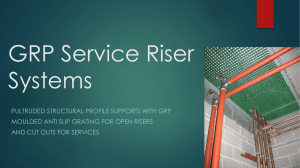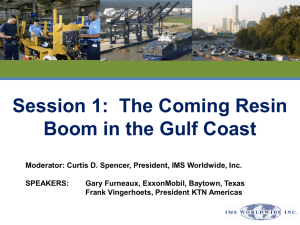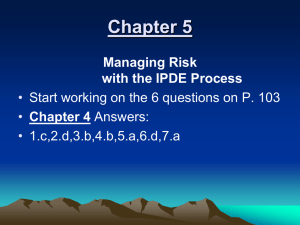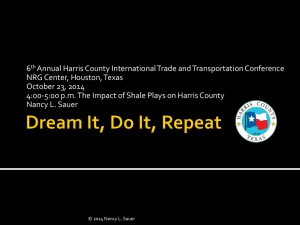Phenolic Molding Compounds are produced by
advertisement
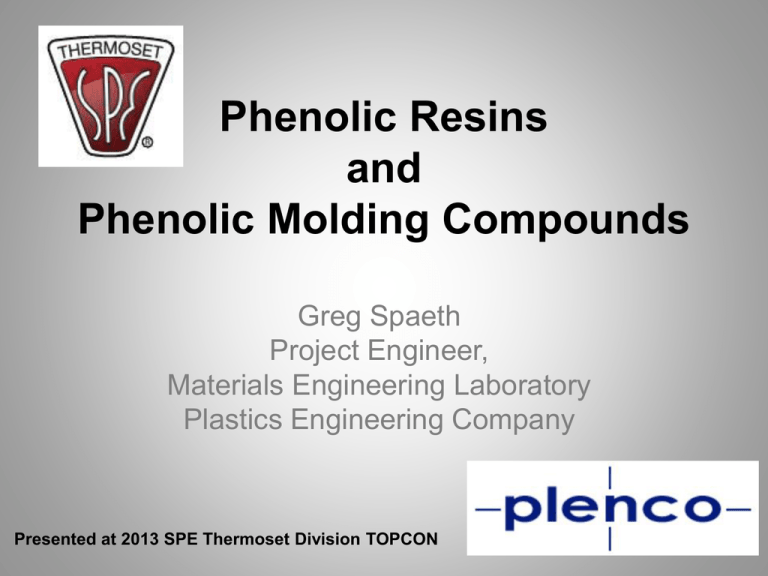
Phenolic Resins and Phenolic Molding Compounds Greg Spaeth Project Engineer, Materials Engineering Laboratory Plastics Engineering Company Presented at 2013 SPE Thermoset Division TOPCON Phenolic Resins Phenolic resins are synthesized in a pressure vessel by repeatedly linking phenolic monomers with aldehyde chemicals Typically phenol and formaldehyde Other phenols include Cresol Cashew nutshell oil Another aldehyde used Furfural Process variations can result in a assortment of resin structures each demonstrating a wide range of properties There are Two Types of Phenolic Resins Novolac Molar excess of phenol Require an external curing agent Two Stage Usually hexamethylenetetramine or “Hexa” Two year shelf life Resol Typically there is a molar excess of formaldehyde Do not require an external curing agent Single Stage Six month shelf life Phenolic Molding Compounds Phenolic Molding Compounds Phenolic Molding Compounds are produced by compounding various fillers with Phenolic Resin Typical Formula 50 % Phenolic Resin, resol or novolac 45 % filler Woodflour Minerals, talc, clay, ATH, etc. Cotton Glass Fibers Carbon Fibers or graphite powder 5 % colorants and lubricants Carbon Black Zinc Stearate The Oil and Natural Gas Mining Process as a Case Study for Phenolic Materials A well begins by drilling a large diameter hole extending below the fresh water A surface casing is inserted to isolate fresh water and support the blow out preventer Cement is pumped into the casing The cement is forced out of the casing and up the well hole sealing of the aquifer Wiper Plugs and Darts Phenolic Core Over molded rubber shell Why Phenolic Molding Compounds? The molded phenolic core provides superior strength and rigidity to enable the wiper plug to withstand the high pressures involved in forcing hundreds of cubic feet of concrete through the well casing High Modulus provides stiffness and stability for the darts mandrel core and tighter griping for the elastomer wiper segments Heat resistance allowing plugs rated for use at 400ºF Easy drill out with small debris The wiper plug is then drill out and the production well is drilled. Production casing is lowered It takes more than 350 casings weighing more then 85 tons to case a 10,500 foot well Cement is once again pumped into the well Again using a wiper plug the cement is force back up the well securing the casing Fracturing the well then begins by lowering a perforation gun down the well casing Small shaped explosives blast holes through the casing, cement, and into the formation Fracturing fluid is pumped into the well The fluid under extreme pressure causes the formation to fracture Resin Coated Proppant Sand Fracturing fluids varies among regions and well types, but typically consists of water (90+%) proppant (9%) and chemicals (<2%) Resin Coated Proppant Sand Once the fracturing fluid is removed, the phenolic resin coated sand remains behind and works as a prop to keep the fissures from sealing on release of pressure Why Phenolic Resin? Phenolic’s high modulus and excellent heat and creep resistance resists fracture under pressure as proven in industry “Conductivity test” Why Phenolic Resin? Chemical Resistance harsh chemicals found down hole can attack various proppant including ceramic proppant Curable Proppant Enables the proppant to remain in place in wells with high pressure flow The now fractured portion of the well is sealed off using fracturing ball Fracturing Balls Fracturing Balls Why Phenolic Molding Compound? Phenolic Balls offer an excellent combination of chemical and heat resistance with superior tensile and compressive strength compared with other plastic balls. Customizable formulations allowing a specific gravity range of 0.8 to 3.5+ The perf gun is again lowered and detonated The perf gun is again lowered and detonated Again fracturing fluid is pumped into the well to fracture the new section of the well while the already fractured section is isolated by the frac ball Fracturing Balls Perforation and well fracturing is repeated as often as needed Once fracturing is complete the balls are usually drilled or floated out Surface equipment is put in place Well begins production Valve Components Valve Components Why Phenolic Molding Compounds? Strength, rigidity, dimensional stability, creep resistance A phenolic back-up ring allows internal pressure to anchor the seat within the valve body and prevents seat walking Non-collapsible, stretch resistant, blow out proof, field replaceable Non-collapsible, stretch resistant, blow out proof, field replaceable Chemical resistance and high hardness Provide valve components that resists corrosive environments and do not deform under pressure allowing for repeated ball sealing Other Applications Corrosive coatings for Storage tanks, semi tank trailers, railroad tank cars, fans blowers, and fin tube coils Binder for Friction pads, brake pads, grinding wheels, plywood and particle board Wear Resistance Gas meter valves, pump seals, caster wheels Dimensional Stability &Thermal Performance Brake pistons, transmission parts, electrical motor brush cards Electrical insulation terminal strips, commutators, capacitor cans and caps Offshore Applications Why Phenolic Resin? Superior Creep Resistance Strength and stability under load Low weight high strength and modulus Strength and rigidity Chemically Resistant Harsh marine environment Excellent flammability resistance and low smoke and toxicity Increased level of safety High carbon and char yield Retains level of strength and integrity should fire break out Phenolic Properties Chemical Resistance Transmission oil,150ºC (302ºF) Salt water, 65ºC (150ºF) Beach, 65ºC (150ºF) Unleaded gasoline, 22ºC (72ºF) E85 Unleaded gasoline, 22ºC (72ºF) SAE 30 Motor oil, 150ºC (302ºF) Propylene glycol, 100ºC (212ºF) Crude oil, 22ºC (72ºF) Phenolic Properties Chemical Resistance Phenolic Properties Chemical Resistance Phenolic Properties Chemical Resistance Phenolic Properties Chemical Resistance Phenolic Properties Chemical Resistance Phenolic Properties Comparison of Phenolic molding compound to engineering grade thermoplastics Thermoplastics 20% fiber glass filled ABS 20% fiber glass filled Acetal 20% fiber glass filled PPA 20% fiber glass filled PPS 20% fiber glass filled Nylon66 Phenolic Molding Compound Glass and mineral filled PLENCO 06404 glass and mineral filled PLENCO 02311 general purpose woodflour filled Data for PLENCO materials available from PLENCO.com, all thermoplastic data from matweb.com overview average values Phenolic Properties Hardness Data for phenolic and PLENCO materials are approximated from E scale Data for PLENCO materials available from PLENCO.com, all thermoplastic data from matweb.com overview average values Phenolic Properties Strength and modulus Data for PLENCO materials available from PLENCO.com, all thermoplastic data from matweb.com overview average values Phenolic Properties Strength and modulus Data for PLENCO materials available from PLENCO.com, all thermoplastic data from matweb.com overview average values Phenolic Properties Compressive Strength Data for PLENCO materials available from PLENCO.com, all thermoplastic data from matweb.com overview average values Phenolic Properties Heat Resistance Phenolic Properties Flammability resistance UL V-0 at 0.5mm IEC 60695 Glow Wire GWFI and GWFI Rating 960ºC+ at 0.75mm ASTM E162 Flame Spread 0.85* *Source: Composites World Author: Michael LeGault Posted on: 2/14/2013 Phenolic Properties Post bake What is it? • Postbaking is a manufacturing step where molded parts are heated in an oven after being removed from the die. Why do it? • • • • Dimensional stabilize a part, especially for high temperature applications Out-gas residual ammonia which is a by product of two stage cure Improve strength Sometimes only because the print tells you to How is it done? • • Ramp oven from room temperature to 15ºC below parts initial tg at 5º/min Ramp oven to desired temperature at 0.5-0.25ºC/min to keep the oven temperature under the parts instantaneous tg Do I need to do it? • Many Applications do not require a postbake, only a thorough understanding of the reasons to postbake will help you answer this question Thank You Questions? Greg Spaeth Project Engineer, Materials Engineering Laboratory Plastics Engineering Company Presented at 2013 SPE Thermoset Division TOPCON
